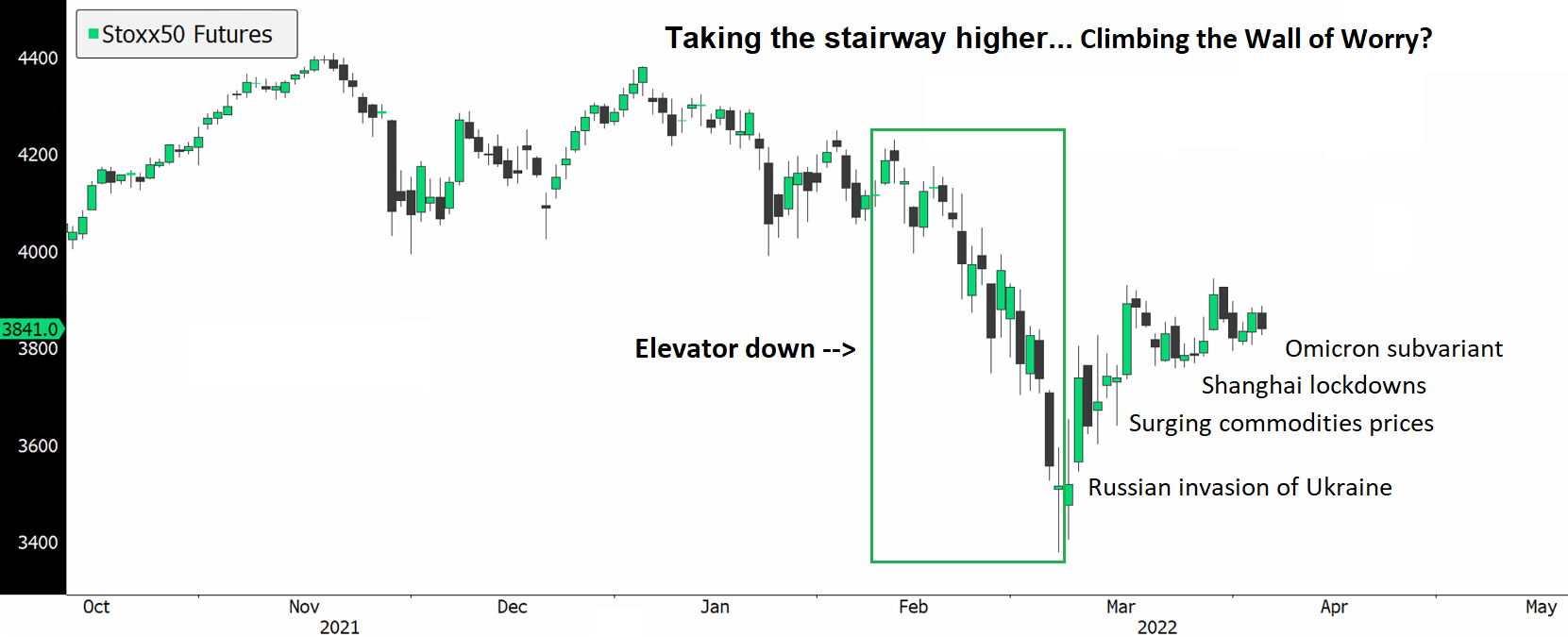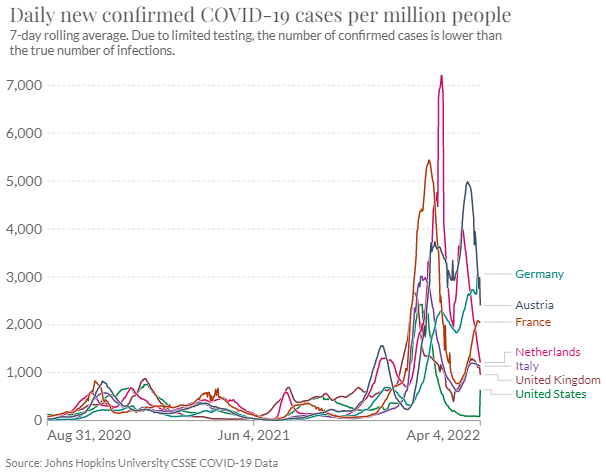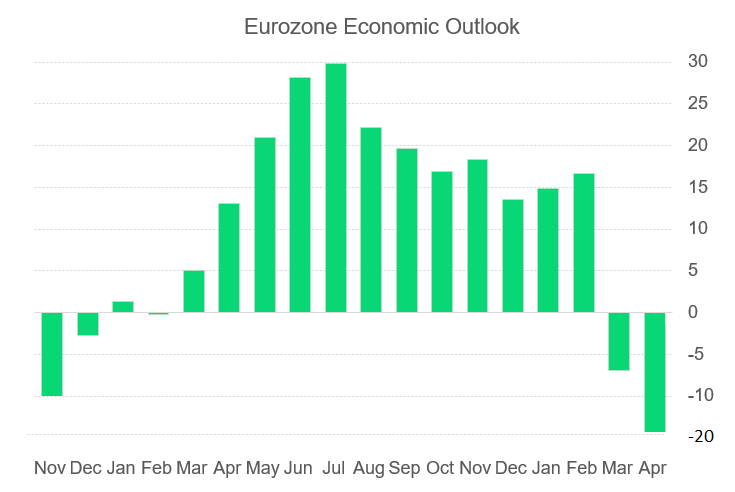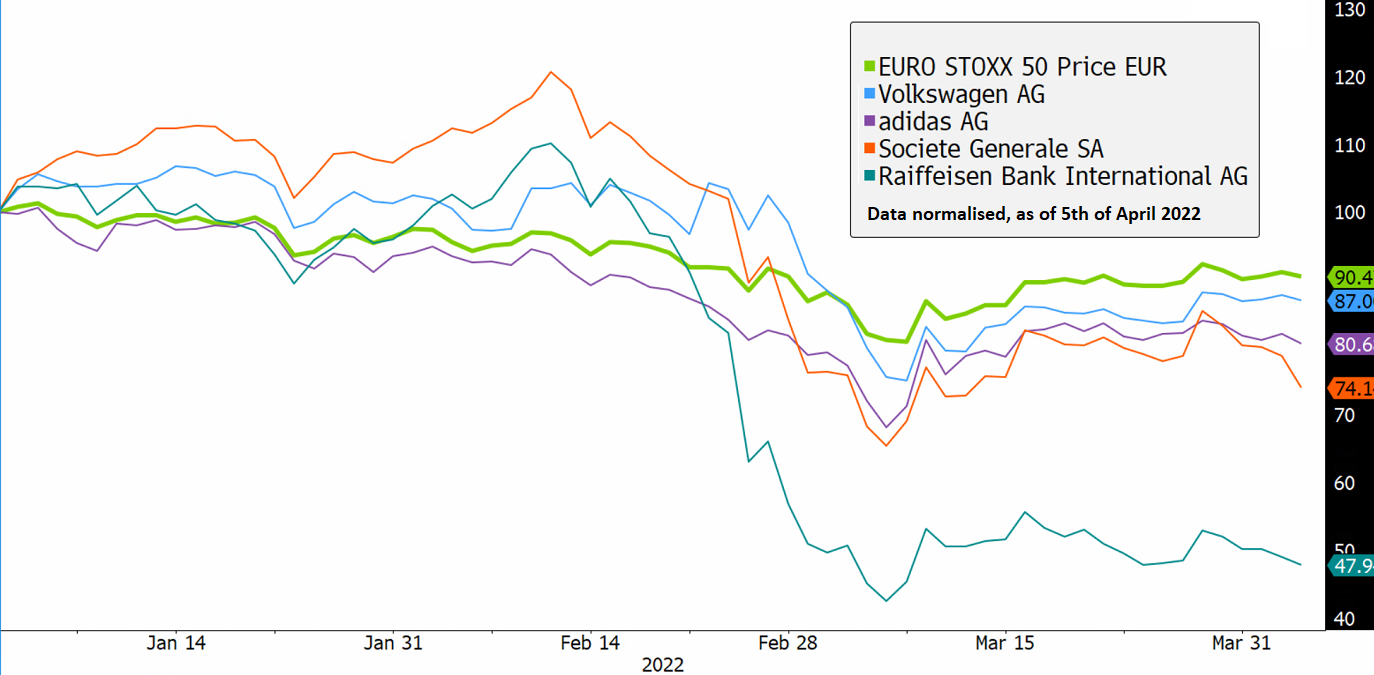The bad news is accumulating for Europe. Questions about a European recession abound. European dependence on Russian energy and grain imports is adding to inflation woes. Volatility is here, but…. is the worst behind us?
Climbing the wall of worry
European stocks took the elevator down as they re-priced the risks in the current environment. Questions remain whether the market has ‘priced-in’ the likely growth deceleration and headwinds the European continent is facing. A ‘wall of worry’ is forming on several fronts.

Covid
As European countries have shed restrictions, cases and hospitalisations are slowly inching up and public health experts are worried about the consequences. So far, cases are high, but people are learning to live with Covid and the reopening is ongoing. Despite the lift of restrictions, there is still the risk of further deterioration due to the spread of the more transmissible Omicron subvariant BA.2.

Supply-chain bottlenecks
Contrary to prior expectations that the pandemic-induced supply-chain shock would begin fading in the latter part of the year, China lockdowns and the war in Ukraine have added to supply-chain woes. Shortages are likely to add to inflationary pressure in Europe and weigh on the economy. Logistics issues are intensifying due to lockdowns, with many delays and container ships queuing for days in some of the worst congestions ever recorded. The delays are adding to costs and alternative transportations are costly. For example, in Shenzhen, trucking costs have shot up some 300%.
The sanctions on Russia are also causing logistics hiccups. For example, more than a million containers due to travel to Europe from China by train, on a route that goes through Russia, must now make their journey by sea. The timeline for the supply-chain crisis to be resolved remains dependent on several factors, and it is increasingly likely that it will take a lot longer now due to the war in Ukraine and the resurgence of Covid cases in China (China’s continuing zero-Covid policy).
Surging food and energy prices
The Ukraine war has added enormous pressure on the costs of food and energy, hurting the wallets of everyday Europeans. Ukraine, along with southwestern Russia accounts for nearly 30% of global wheat exports, while Russia and Ukraine together account for 80% of global sunflower oil production. Ukraine is also the fourth largest exporter of maize. This could lead to supermarkets in Europe significantly raising their prices.
Governments have already announced subsidies to attempt to limit the effects on consumers, which may have to curb their spending. The surge in food and energy costs will surely pile pressure on European farmers and energy companies, perhaps leading to governments intervening in more significant ways to alleviate the pressure on everyday Europeans.
The war: growth, trade & prolonged inflation
With the latest European business and consumer surveys polling quickly falling confidence, the war is having impacting on growth. These risks are materialised for companies with exposure in Russia and Ukraine. For example, it is more difficult to source key auto parts manufactured in Ukraine, adding to the woes of supply-chain bottlenecks. The war in Ukraine is delaying or cutting off supplies of materials and products needed by companies that make cables, seat covers, and other automobile parts, among some of the many issues. Risks of prolonged conflicts and sanctions bring in high uncertainty and fears of persistent inflation. At the end of March, Germany already revised lower its GDP growth forecasts by more than half to 1.8% for 2022 and flagged a ‘substantial’ recession risk because of the conflict with Russia. Unlike the US, the German economy has not fully recovered to pre-pandemic levels and is not expected to do so until the third quarter of 2022.
Sentiment
Investor morale, according to the Sentix Investor Confidence slumped to the lowest level since July 2020 in the Eurozone. The war in Ukraine and discussions about further sanctions on Russia continue to weigh on sentiment and add to inflation risks. While the threat of an immediate cut-off in Russian gas supplies has somewhat eased, providing hope that the worst might be behind us, investors are still worried, and that worry can hurt economic growth in the region.

Are higher rates largely “priced-in”?
The European Central Bank (ECB) vowed to keep its options open given the current environment, which is adding pressure on the bank to support the economy and manage inflation which has spun out of the 2% target. Eurozone inflation hit 5.8% in February, and commodities prices have surged since then due to the war.
While some ECB policymakers call for a faster exit of the pandemic era stimulus, the consensus at the institution remains for a measured response to inflation.
Money markets have priced in 45-basis points in hikes by year-end, while ECB officials have only hinted at one possible hike by year-end. With the looming fog of war, it is quite likely that the response from central bankers may prove more limited than the market has priced, as Europe faces several challenges that could see its economy naturally slowing down. Likely, it could be that a first hike doesn’t occur until 2023, and as ECB Chief Christine Lagarde has said: the ECB is in no hurry to raise rates and any moves will be gradual. Lagarde also added that a possible hike would come after the ECB bond-buying program ends, slated for now in the third quarter of 2022.
What are markets whispering?
Markets found a bottom on 8 March, about 10 days after the Russian invasion (24 February), partly recovering some of the losses incurred in what is the biggest market correction since March 2020. While it remains uncertain how European companies will be able to cope with the new environment and how margins will be affected, the market has begun to look past that. The market is telling us that European companies are resilient and will adapt to the new environment, better than investors feared in mid-March.

In terms of sectors, recession-proof segments of the market such as parts of technology and renewables may come out of the crisis as winners due to resilience in demand and because of the key role they play in modernising the European economy, for instance.
Consumer discretionary such as luxury groups could be particularly vulnerable to a growth slowdown and hiccups in China, where the demand is significant. Banks could suffer more due to their sensitivity to economic cycles and potential exposure to Russian sanctions. In addition, multinational groups with broad diversification and significant pricing power should have more resources to re-adjust supply chains and face rising costs, to sail through the storm.
Conclusion
With bad news accumulating for Europe, investor sentiment is down significantly, and investors may be ruling out a potential positive scenario for European stocks, coming out of the crisis. Investors could also consider that the US may outperform Europe because it is less exposed to the conflict with Russia and broad US indices have a large technology weight which could provide stability and resilience in a low growth environment. Only time will tell if the worst is behind us and if European equities are close to having ‘priced-in’ the current crisis.





